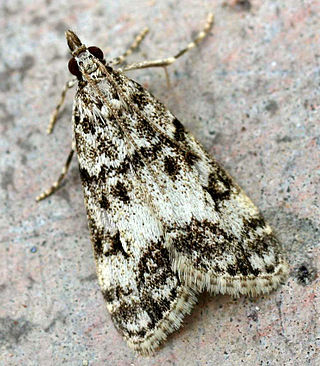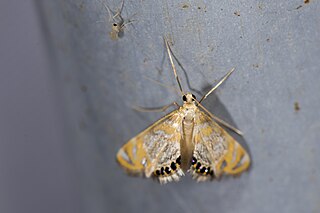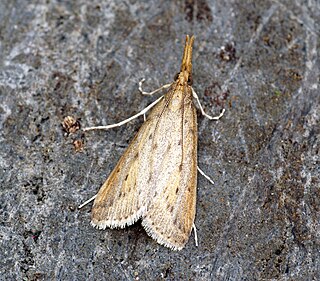Related Research Articles

Crambidae comprises the grass moth family of lepidopterans. They are variable in appearance, with the nominal subfamily Crambinae taking up closely folded postures on grass stems where they are inconspicuous, while other subfamilies include brightly coloured and patterned insects that rest in wing-spread attitudes.

The Pyralidae, commonly called pyralid moths, snout moths or grass moths, are a family of Lepidoptera in the ditrysian superfamily Pyraloidea. In many classifications, the grass moths (Crambidae) are included in the Pyralidae as a subfamily, making the combined group one of the largest families in the Lepidoptera. The latest review by Eugene G. Munroe and Maria Alma Solis retain the Crambidae as a full family of Pyraloidea.

The Pyraloidea are a moth superfamily containing about 16,000 described species worldwide, and probably at least as many more remain to be described. They are generally fairly small moths, and as such, they have been traditionally associated with the paraphyletic Microlepidoptera.

Schoenobius gigantella is a species of moth of the family Crambidae. It is found in Europe and China.

Eudonia lacustrata is a species of moth of the family Crambidae described by Georg Wolfgang Franz Panzer in 1804. It is found in Europe, north-west Africa, Asia from Turkey, Iran and Syria to Siberia and the western part of China (Hunan). The subspecies E. lacustrata persica is found in Iran and Armenia.

Eudonia mercurella is a species of moth of the family Crambidae. It is found in Europe, western China, Iran, Lebanon, Turkey, and north-western Africa.

Calamotropha is a genus of moths of the family Crambidae.

Elophila is a genus of moths of the family Crambidae described by Jacob Hübner in 1822.

Eoophyla is a genus of moths of the family Crambidae. It was erected by Charles Swinhoe in 1900.

Eudonia is a large and widespread genus in the grass moth family (Crambidae), subfamily Scopariinae. There is no common name for the roughly 250 species placed here; new species are still being described regularly. Although the genus was proposed early in the 19th century, many of these moths were for a long time retained in Scoparia, the type genus of the subfamily and a close relative of Eudonia. A few small genera have been proposed for separation from Eudonia, but given the size of this group this is not particularly convincing; thus, all are retained here pending a comprehensive phylogenetic review.

Nymphicula is a genus of moths of the family Crambidae.

Parapoynx is a genus of moths of the family Crambidae described by Jacob Hübner in 1825.
Syrianarpia is a genus of moths of the family Crambidae.

Scoparia is a grass moth genus of subfamily Scopariinae. Some authors have assigned the synonymous taxon Sineudonia to the snout moth family (Pyralidae), where all grass moths were once also included, but this seems to be in error.
Syrianarpia mendicalis is a species of moth in the family Crambidae. It is found in Ukraine, Turkey and Iran.
Syrianarpia faunieralis is a species of moth in the family Crambidae described by Mauro Gianti in 2005. It is found in the Cottian Alps in Italy.

Glaphyriinae is a subfamily of the lepidopteran family Crambidae. It was described by William Trowbridge Merrifield Forbes in 1923. The subfamily currently comprises 509 species in 75 genera.

Schoenobiinae is a subfamily of the lepidopteran family Crambidae. The subfamily was described by Philogène Auguste Joseph Duponchel in 1846.

Scopariinae is a subfamily of the lepidopteran family Crambidae. The subfamily was described by Achille Guenée in 1854.
References
- ↑ Nuss, M.; et al. (2003–2012). "GlobIZ search". Global Information System on Pyraloidea. Retrieved 2012-03-07.
- ↑ Gianti, Mauro (2004). "Syrianarpia faunieralis sp. n. from the Cottian Alps of Italy (Crambidae: Scopariinae)". Nota Lepidopterologica. 27 (4): 299–302. ISSN 0342-7536 – via Internet Archive.